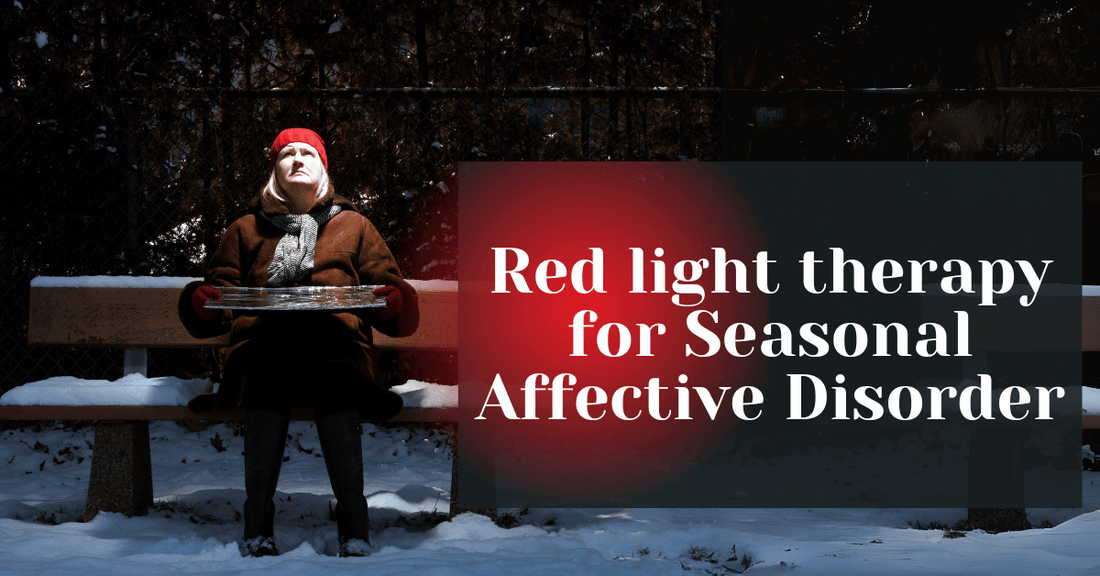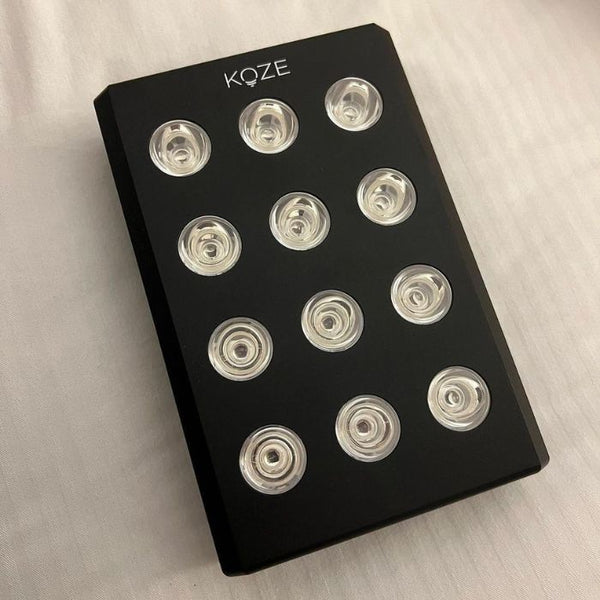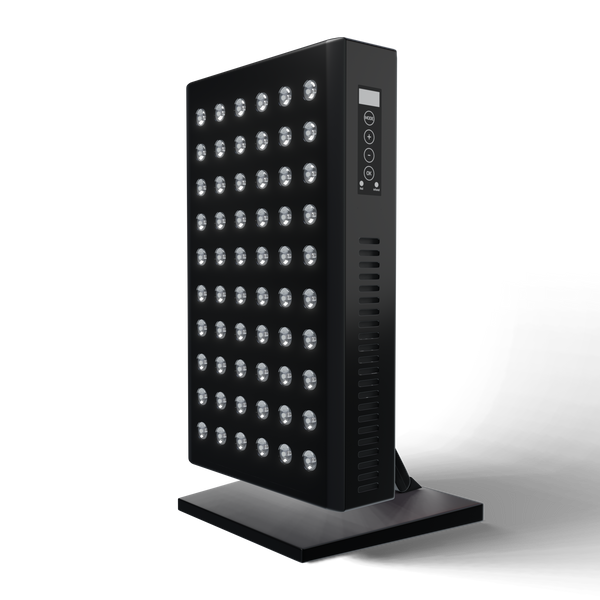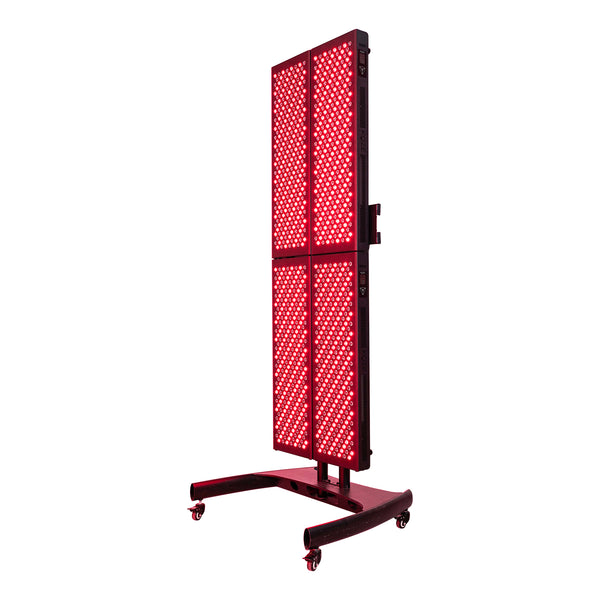
Red light therapy for Seasonal Affective Disorder
Seasonal Affective Disorder (SAD), or seasonal depression, is a type of depression that occurs at a specific time of the year, usually in the fall or the dark winter months when there is less natural sunlight. It is characterized by feelings of sadness, depression, lethargy, and a lack of interest in activities that were once enjoyable. As the prevalence of SAD, or seasonal depression, continues to rise, many are seeking alternative treatments to traditional methods such as antidepressant medications and psychotherapy.
One such alternative is Red Light Therapy (RLT), a non-invasive treatment that has shown promise in alleviating symptoms of bipolar disorder, major depression, and sleep disorders, including SAD. This blog post aims to provide a comprehensive guide to understanding how red light therapy can be a beneficial treatment for managing seasonal affective disorder. We will explore the science behind RLT, its many benefits, how to use it effectively, and what to consider before starting treatment.
By the end of this post, you will have a deeper understanding of how red light therapy can offer pain relief even to those suffering from SAD and how it can be integrated into your overall mental health strategy.
What is red-light therapy?

Red light therapy (RLT), also known as low-level laser therapy (LLLT) or photobiomodulation (PBM), is a treatment that uses specific wavelengths of red and near-infrared light to promote healing and alleviate various health conditions. Unlike ultraviolet light, which can damage the skin, red light therapy is safe and non-invasive.
Definition and Explanation of Red Light Therapy
Red light therapy involves exposing the skin to a lamp, device, or laser that emits red light. The most commonly used wavelengths range from 630 to 660 nanometers (nm) for red light exposure, and 810 to 850 nm for near-infrared light exposure. These wavelengths of light intensity penetrate the skin to varying depths and are absorbed by the cells, triggering a series of biological processes.
How Red Light Therapy Works
When cells absorb red and near-infrared light, it stimulates the production of adenosine triphosphate (ATP), the energy currency of the cell. This boost in ATP production enhances cellular function and regeneration, leading to various therapeutic effects. RLT also increases blood circulation, reduces inflammation, and stimulates collagen production, which can improve skin health and wound healing.
The Science Behind Red Light Therapy and Its Effects on the Brain
Recent research has explored the effects of red light therapy on the brain, particularly its potential to improve mood and cognitive function. One theory is that RLT increases the activity of mitochondria in brain cells, leading to enhanced energy production and reduced oxidative stress. This can result in improved neuronal function and mood regulation.
Studies have also suggested that red light therapy may increase the release of neurotransmitters like serotonin and dopamine, which play a crucial role in mood regulation. By modulating these neurotransmitters, RLT could potentially alleviate symptoms of seasonal mood disorders, seasonal and depression symptoms, and anxiety, making it a promising treatment management option for seasonal affective disorder.
KOZE™ Mini:
With the KOZE™ Mini, you may enjoy the advantages of phototherapy in the comfort of your own home or place of business. It is a small, multipurpose light therapy gadget. For individuals looking for a practical way to elevate their mood, improve sleep quality in their often poor sleep quality, or increase the quality of their skin, this portable device is ideal.
Koze S Series:
A cutting-edge light treatment system, the Koze S Series was created to meet the changing demands of contemporary wellness aficionados. With the many adjustable options this cutting-edge series offers, users may customize their natural light and therapy experience to meet their own wellness, physical performance and mental health, objectives
Koze X Series:
The Koze X Series is the epitome of light treatment technology, providing an unmatched experience for individuals looking for the most cutting-edge innovations in wellness. This high-end series offers a complete solution for a variety of health and wellness demands by fusing cutting-edge features with stylish design.
The Link Between Red Light Therapy and Seasonal Affective Disorder
Seasonal Affective Disorder (SAD) is a form of depression that occurs in a seasonal pattern, typically emerging in the fall and winter months when daylight hours are shorter. The reduced exposure to natural sunlight during these periods can disrupt the body's internal clock, leading to feelings of depression, fatigue, and other symptoms associated with SAD.
How Red Light Therapy May Alleviate SAD Symptoms
Red light therapy has emerged as a potential treatment for managing SAD due to its ability to mimic the antidepressant effects of natural light and sunlight. The wavelengths of natural light being used in RLT can penetrate the skin and reach the brain, where they can stimulate the production of neurotransmitters like serotonin, often referred to as the "feel-good" hormone. An increase in serotonin levels can help alleviate the symptoms of depression associated with SAD.
Moreover, red light therapy can help regulate the body's circadian rhythm, which is often disrupted in individuals with SAD. By simulating the effects of extended periods of sunlight, or more than natural light exposure, RLT can assist in resetting the body's internal clock, leading to improved sleep patterns and mood regulation.
Research and Studies
Several studies have explored the effectiveness of red light therapy in managing SAD. One study found that participants who received RLT showed significant improvements in mood and depression symptoms compared to those who did not receive the treatment. Another study indicated that red light therapy could enhance cognitive function and reduce fatigue, both of which are common issues in individuals with SAD.
While clinical research on the use of RLT as an active treatment for SAD is still in its early stages, the results so far are promising. Red light therapy's ability to improve mood, regulate sleep, and increase energy levels makes it a potential complementary and active treatment for seasonal affective disorder.
Dr. Michael Hamblin of Harvard Medical School is one of the world's leading photomedicine researchers, and a member of Joovv's Scientific Advisory Board. He believes that in addition to the brain, more natural light is also absorbed “systematically through the skin,” resulting in increased circulation, which may positively impact the brain
Benefits of Red Light Therapy for Seasonal Affective Disorder
Red Light Therapy (RLT) has shown promise well being used as a complementary management for seasonal affective disorder (SAD), offering several potential benefits that can help alleviate severe symptoms, depression symptoms, and sleep disorders and improve overall well-being. Here are some of the key benefits of using red light therapy for SAD:
1. Improvement in Mood
One of the primary benefits of red light therapy for SAD is its ability to enhance mood. By stimulating the production of neurotransmitters such as serotonin and dopamine, RLT can help reduce feelings of depression and anxiety, leading to a more positive emotional state.
2. Regulation of Circadian Rhythm
RLT can help regulate the body's internal clock, which is often disrupted in individuals with SAD. By mimicking the effects of more natural light than sunlight, red light therapy can assist in resetting circadian rhythms, leading to improved sleep patterns and better overall mood regulation.
3. Reduction in Fatigue
Many people with SAD experience increased fatigue during the fall and winter months. Red light therapy has been shown to boost energy levels and reduce fatigue by reducing inflammation and enhancing mitochondrial function and ATP production in cells.
4. Enhanced Cognitive Function
RLT can also have positive effects on cognitive function. Studies suggest that red light therapy may improve focus, clarity of thought, and memory, which can be particularly beneficial for those experiencing the cognitive symptoms of SAD.
5. Non-Invasive and Safe
Red light therapy is a non-invasive and safe treatment option with minimal side effects. It can be easily incorporated into daily routines and used in the comfort of one's home, making it an accessible option for managing SAD symptoms.
6. Complementary to Other Treatments
RLT can be used alongside other treatments for SAD, such as light therapy with bright white light, medication, and psychotherapy. Combining red light therapy with these traditional treatments may enhance their effectiveness and provide more comprehensive relief from symptoms.
How to Use Red Light Therapy for Seasonal Affective Disorder
Incorporating red light therapy into your routine to combat seasonal affective disorder (SAD) is relatively simple. Here are some guidelines to help you get started:
1. Choose the Right Device
Select a red or light box or light therapy device that emits wavelengths in the range of 630–660 nm for red light and 810–850 nm for near-infrared light. Look for bright light therapy or natural light from light box devices specifically designed for home use, such as panels, light boxes, lamp light boxes, or handheld light box devices.
2. Set Up Your Treatment Space
Create a comfortable space for your red light therapy sessions. Ensure that the area is clean and free from distractions. You can use a chair or a comfortable seating area where you can relax during the treatment.
3. Determine the Duration and Frequency
Start with shorter sessions, around 10–15 minutes per day, and gradually increase the duration as needed. Most people find that daily sessions are effective, but you can adjust the frequency based on your response to the therapy.
4. Position the Device Correctly
Place the red light therapy device at a distance where the starting light therapy itself can cover the targeted area evenly. For SAD, it's important to focus on exposing the face and head to the starting of the light therapy red light therapy depression exposure before starting the red light exposure or starting the light exposure therapy depression, at first, as this is where the red light therapy depression can have the most impact on mood regulation.
5. Protect Your Eyes
Although red light therapy is generally safe for the eyes, it's a good idea to wear protective goggles or close your eyes during the session to avoid any discomfort.
6. Monitor Your Progress
Keep track of your sessions and take note of any changes in your mood, energy levels, joint pain relief, and overall well-being. This will help you determine the effectiveness of the treatment and make any necessary adjustments.
7. Consult with a Healthcare Professional
Before starting red light therapy, it's important to consult with a healthcare or mental health professional, especially if you have existing mental health problems or conditions or are undergoing other treatments for SAD.
Potential Side Effects and Considerations
While red light therapy is generally considered safe and non-invasive, there are some potential side effects and considerations to keep in mind when using it as a treatment for seasonal affective disorder (SAD).
1. Mild Skin Irritation
Some individuals may experience mild skin irritation, redness, or itching at the site of application. These symptoms are usually temporary and resolve on their own. If you have sensitive skin, it's advisable to start with shorter sessions and gradually increase the light intensity and duration as your skin adjusts.
2. Eye Safety
Direct exposure to intense red light can potentially harm the eyes. Although the risk is very low-level light therapy only, it's important to use eye protection or avoid looking directly into the light source during low level light therapy sessions.
3. Interference with Medications
Red light therapy can interact with certain medications, particularly those that increase photosensitivity, such as some antibiotics, antipsychotics, and acne treatments. Consult your healthcare provider before starting RLT if you are taking any medications.
4. Underlying Health Conditions
Individuals with certain mental health or conditions, such as psychological disorders or mood disorders, severe depression, major depressive disorder or bipolar disorder, or mental health, such as sleep disorders or physical performance, such as photosensitive skin disorders or a history of skin cancer, should exercise caution and seek medical advice before using red light therapy.
5. Pregnancy and Nursing
The safety of red light therapy during pregnancy and breastfeeding is not well-established. Pregnant or nursing individuals should consult their healthcare provider before undergoing RLT.
6. Expectation Management
While red-light therapy can be beneficial for SAD, it may not work for everyone. It's important to manage expectations and consider RLT as part of a comprehensive treatment plan that may include other therapies and lifestyle changes.
7. Quality of Devices
The effectiveness of a red light therapy device depends on the quality of the device used. It's essential to choose a device that emits the appropriate wavelengths and intensities of light for therapeutic purposes. Research and read reviews before purchasing a red light therapy device for home use.
Frequently Asked Questions (FAQs)
Q1: Is red light therapy scientifically proven to treat seasonal affective disorder (SAD)?
A1: While clinical research on consistent use of red light therapy for SAD is still emerging, initial studies and anecdotal evidence suggest it can be beneficial in alleviating symptoms of bipolar disorder. However, more extensive clinical research is needed to fully establish its efficacy.
Q2: How often should I use red light therapy for SAD?
A2: The frequency of red light therapy sessions can vary depending on the individual and the severity of their symptoms. It's common to start with shorter sessions (10–15 minutes) a few times a week and adjust based on your response to the treatment. Consult with a healthcare professional for personalized recommendations.
Q3: Can I use red light therapy alongside other treatments for SAD?
A3: Yes, red light therapy can be used in conjunction with other treatments for SAD, such as light therapy with a bright light or white light, medication, and psychotherapy. It's important to discuss your treatment plan with your healthcare provider to ensure the best approach for your specific needs.
Q4: Are there any long-term side effects of using red light therapy?
A4: Red light therapy is generally considered a safe and effective treatment with minimal long-term side effects. However, as with any treatment, it's important to use the bright light therapy as directed and consult with a healthcare professional if you have any concerns.
Q5: How long does it take to see results from red light therapy for SAD?
A5: The time it takes to take red light therapy and see results can vary from person to person. Some individuals may notice improvements in their mood and energy levels within a few weeks, while others other benefits may take several weeks longer. Consistency is key, and it's important to give the treatment time to work.
Q6: Can red light therapy be used to treat other forms psychological disorders of mental health problems besides clinical depression?
A6: Preliminary research suggests that red light therapy may have potential in treating other forms of depression, but more studies are needed to fully understand its effectiveness. Always consult with a healthcare or mental health professional before using red light therapy for any mental health condition.
Q7: Is red light therapy a safe and effective treatment for children and adolescents with SAD?
A7: There is limited research on the use of red light therapy in children and adolescents with SAD. It's essential to consult with a pediatrician or mental health professional before starting any new treatment for young individuals.
Q8. How can KOZE HEALTH help with managing SAD?
A8: Koze Health offers a range of red light therapy devices that are designed to provide the therapeutic benefits of red light in the comfort of your home. Their products can help improve mood, regulate sleep patterns, and boost energy levels, making them a valuable tool in managing the symptoms of seasonal affective disorder.
Conclusion
In conclusion, red light therapy presents a promising alternative for individuals seeking relief from seasonal affective disorder (SAD). By harnessing the therapeutic power of specific wavelengths of natural light alone, RLT offers a non-invasive and safe option that can also improve sleep quality and mood, regulate the circadian rhythm, and enhance overall well-being.
Koze Health provides high-quality red light therapy devices that can be easily incorporated into your daily routine to help manage the symptoms of SAD. Their products are designed to deliver the optimal wavelengths and intensity of natural light for effective treatment, ensuring you receive the maximum benefits of red light therapy in the comfort of your own home.
As with any treatment for major depressive disorder or clinical depression, it's important to consult with a healthcare professional before starting red light therapy, especially if you have underlying mental health conditions or are taking medications. With the right approach and tools, such as those offered by Koze Health, you can effectively address the challenges of major depressive disorder and seasonal affective disorder and improve your quality of life during the darker months of the year.
References
1. Terman, M., & Terman, J. S. (2005). Light therapy for both seasonal depression and nonseasonal depression: efficacy, protocol, safety, and side effects. CNS Spectrums, 10(8), 647-663.
2. Golden, R. N., Gaynes, B. N., Ekstrom, R. D., Hamer, R. M., Jacobsen, F. M., Suppes, T., ... & Nemeroff, C. B. (2005). The efficacy of light therapy in the treatment of mood disorders clinical as major depression alone: a review and meta-analysis of the evidence. American Journal of Psychiatry, 162(4), 656-662.
3. Lieverse, R., Van Someren, E. J., Nielen, M. M., Uitdehaag, B. M., Smit, J. H., & Hoogendijk, W. J. (2011). Bright light treatment in elderly patients with nonseasonal major depressive disorder: a randomized placebo-controlled trial. Archives of General Psychiatry, 68(1), 61-70.
4. Schiffer, F., Johnston, A. L., Ravichandran, C., Polcari, A., Teicher, M. H., Webb, R. H., & Hamblin, M. R. (2009). Psychological benefits 2, several weeks, and 4 weeks after a single treatment with near-infrared light to the forehead: a pilot study of placebo effect in 10 patients with major depression and anxiety. Behavioral and Brain Functions, 5(1), 46.
5. Barrett, D. W., & Gonzalez-Lima, F. (2013). Transcranial infrared laser stimulation produces beneficial cognitive and emotional effects in humans. Neuroscience, 230, 13-23.


